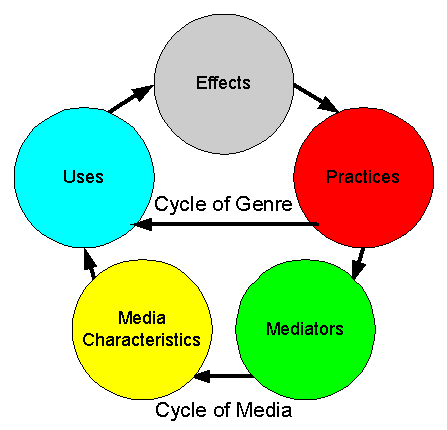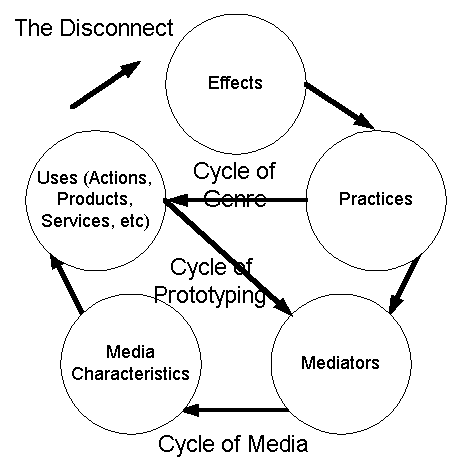An Extended Abstract for a Poster Session at the NCA Summer Conference, 2002
Communication Media: Spheres Of Invention
Davis Foulger
davis@foulger.info
Oswego State University (SUNY)
A medium of communication is a system that enables the flow of messages between one or more creators of messages and one or more receivers of messages. The range of media therefore includes such simple systems as face-to-face communication, in which human modalities, light, and air are all that is necessary to enable communication and such complex media as television, in which a broad range of intermediate elements (e.g. mediators) are used as a system to route messages from a small number of message creators to a large number of message consumers.
New communication media are invented in five interrelated "spheres" of invention as shown in Figure 1: mediators, characteristics, uses, effects, and practices. The “invention” of a medium entails invention activity in all of these spheres, with changes any one sphere provoking activity in others. The most common paths for such provocations are shown as the Cycle of Media and Cycle of Genre in Figure 1.
 |
|
Figure 1: The Spheres of Invention in Media
|
Mediators are the fundamental building blocks of media, and include (using the telephone as an example) such things as telephones, telephone wires, telephone switches, operators, and billing systems. All media entail mediators. Even face-to-face communication depends on human modalities and the natural resources (air and light) that allow them to function. New media are built in the sphere of mediators, with resources (including technologies and people) organized (in structure and process) to support the creation and consumption of messages.
Characteristics are generic attributes of a medium that describe its essential capabilities. The most obvious characteristics of media are the speed with which a message travels, the size of the audience, the time a message persists, and the production and sensory modalities it supports. There are hundreds of operationalizable characteristics with which media can be described and compared. Such comparisons matter, as characteristics determine the kinds of things a medium will be useful for. Media are most likely to succeed when they have a distinctive set of characteristics that either makes new uses of media possible or which allow the medium to do a better job for existing uses than other media do. The more distinctive those characteristics are, the more uses a new medium is likely to have and the more successful a medium is likely to be.
Uses are the things media are used for. Research traditions like uses and gratifications have identified highly generic uses that are associated with various media, including entertainment, gaining and sharing information, establishing personal identity, integration and social interaction, and others. In practice, our uses of media tend to be much more specific than these generic uses suggest. There is a huge difference between getting news and finding information; between getting local news and international news; between learning about how your children are doing and how your tax dollars are being spent; between looking up commonly sought information and finding esoteric information. Television, radio, newspapers, magazines, books, journals, telephones, face-to-face interactions, web search engines, and computer conferences each have advantages relative to one or another of these variations in information finding.
Use implies effect. As is the case in the other spheres, effects are social inventions whose reality is in our belief. The perception that effects of media use are beneficial will increase use of the medium. The perception that effect are problematic will provoke calls for restrictions and myths of inferiority. Most successful media will be seen as both beneficial and problematic as they diffuse into the marketplace. Indeed, a desirable effect for one person (e.g. awareness of products through television commercials) can easily be problematic for another (e.g. encouraging children to smoke, drink or act immorally).
Where there is general agreement that an effect of a medium is problematic, a solution is generally enacted in rules and enforcement mechanisms that make the problems disappear, or in structural practices that control the problem (e.g. proofreading of manuscripts before publication). Wherever value is found in the effects of a medium (whether or not there is agreement concerning that value), that value will be reinforced through the repetitive use of strategic/generic practices that appear to be effective in achieving particular effects. Even where genres transcend media (e.g. romance), generic practice will differ from one medium to another (e.g. valentine’s day cards, anniversary cards and gifts, romance novels, dating behavior, telephone use, love letters, romantic comedies, proposals and ritual ceremonies like weddings).
In some cases these practices are formalized as mediators, thus completing a “cycle of media” (Figure 1) through which media continue to evolve after the initial cycle of invention is complete. In others effects and resulting practices result optimize use and suggest new uses in a “cycle of genre”. These cycles play a continuing role in the evolution of all media, with successful media continuously improving existing and establishing new uses; with established media reacting to successful competitor media by focusing on niches.
Another cycle, the cycle of prototyping (Figure 2) reflects the common design methodology (e.g. use cases in software development) of building systems to the pre-defined requirements of its anticipated users. Note the problem (the disconnect) associated with presuming that understanding requirements adequately informs system design. The cycles of media and genre cannot operate efficiently until the medium is actually used such that effects and practices can be bid and negotiated. It is then that the real work of inventing and evolving media begins.
 |
|
Figure 2: The Cycle of Prototyping and the Disconnect
|
Foulger, Davis. The Invention and Evolution of Media. Paper accepted to National Communication Assocation Fall Conference, 2002.